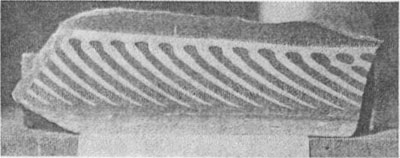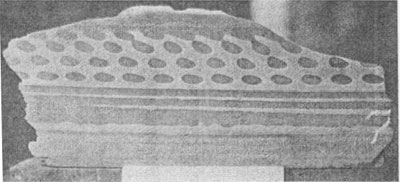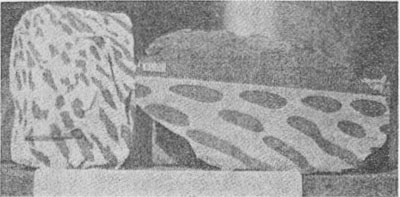| Home | AmMin | GMR | RiMG | Collectors Corner | Directory | Short Courses | |
|
|
|||||||

|
|
Volume 16, pages 221-225, 1931 "ZEBRA" ROCK DAVID W. TRAINER, JR., Cornell University. INTRODUCTION Recently, the author was loaned for study purposes several specimens of the so-called "Zebra" rock, from near Argyle Station, East Kimberly, Western Australia, (Lat. 16° 15', Long. 128° 40'), by Mr. George L. English, consulting mineralogist of Ward's Natural Science Establishment of Rochester, New York. A similar rock has been noted by T. Blatchford near Braeside Station on the Oakover River near the previously referred to locality, but it was not found in place.1 The "Zebra" rock from Argyle Station has been mentioned, its general microscopic characteristics and occurrence described by T. Blatchford. 2 The author is very fortunate in having had the use of an unpublished abstract of a paper dealing with this interesting formation which was read by Mr. R. A. Hobson before the Royal Society of Western Australia on July 8, 1930. This abstract gives the probable theories which may account for the peculiar banding in the rock and a diagrammatic cross-section showing the stratigraphic portion and general field relations of the formation .3The purpose of this paper is to sketch briefly the facts known about the age and the occurrence of the "Zebra" rock, describe it from a macroscopic and microscopic standpoint and suggest some explanation which may account for its banded nature. OCCURRENCE AND CHARACTERISTICS According to the diagrammatic cross-section by Mr. Hobson, the "Zebra" rock lies unconformably on the Pre-Cambrian of the region and directly below a limestone containing the small gastropod, Salterella hardmanni. Forms similar to this have been described by Hall and Wallcott and referred to the Lower Cambrian in North America. It would seem, therefore, from the conformable relation which exists between the bedded "Zebra" rock and the Lower Cambrian limestone above it, the unconformity between the base of the "Zebra" rock and the Pre-Cambrian, that the formation under discussion is probably of Lower Cambrian Age. 4A macroscopic examination of the specimen reveals that the rock is hard, very fine grained, has no apparent textural variations throughout its mass and breaks into smooth unevenly shaped fragments. The weathered surfaces have small cavities which are filled with a white material in the unweathered specimens. (See Fig. 1). The dark bands of the rock vary slightly in color in different specimens, from a light to a medium dark maroon (3K to 3M), while the light portions are very near a light grayish green (25 g 4).1 Some of the specimens also show a leached or lighter colored portion or halo around the dark globular masses, this phenomena may be genetically connected with the banding and distribution of the color in the rock. (See Fig. 2).
Thin sections of the rock cut through adjoining light and dark areas, and a light area between two darker ones, show several very interesting facts. The extremely fine grained nature of the rock is confirmed, the constituent particles being so small that identification can not be made with any degree of certainty. Quartz and chlorite occur in grains large enough to be readily recognized. There are two types of quartz grains, one which is identified by its characteristic "blick" on rotation under crossed nicols, and the second which exhibits wavy extinction. The wavy extinction may be due to the successive extinction of a compound grain as suggested by Grawe. 5 It was first thought that these grains were orthoclase, but an examination of spectrograms of both the light and dark colored portions of the rock taken with a quartz spectrograph showed that there was no potassium present. Chlorite flakes are found oriented in parallel position and this arrangement is constant across both the light and dark bands. The only essential difference in mineral composition between the two portions of the rock is the presence of hematite in the darker areas. The hematite is very finely disseminated through the darker parts and appears to grade gradually into the lighter portions. What appears to be limonite in reflected light is scattered through the lighter parts of the rock in a manner similar to that of hematite in the darker portions. The cavities mentioned in the macroscopic description are empty and, show a slight concentration of hematite around them.ORIGIN OF THE ROCK AND BANDING The origin of the "Zebra" rock, aside from its peculiar banding which is secondary, has not been suggested. The microscopic examination of thin sections leads the author to believe that the rock was originally a very fine grained detrital sediment. The reason for this statement is the fact that in some of the fine grained Paleozoic sediments this association of detrital and secondary quartz, in a fine grained ground mass containing chlorite, is very common. As an example, some of the finer Upper Devonian shales of central New York may be cited. Blatchford has found volcanic tuffs and breccias interlaminated with the rocks of the region and it is very likely also that the "Zebra" rock may be a fine grained representative of such a volcanic series.There appear to be four explanations which may account for the very peculiar and regular banding noticed in the rock. They are: (1) original sedimentary banding of materials varying in composition sufficiently to give red and white colored bands, followed by deformation before complete solidification; (2) original markings due to crystallization of a fine grained flow rock, such as the leopardite from North Carolina (see Fig. 3 for comparison); (3) the result of infiltration of iron-bearing solutions into a uniformly white rock; or (4) due to the leaching of the hematite from a uniformly colored red rock.
CONCLUSION The four explanations for the peculiar banding described in the "Zebra" rock are not especially convincing, but they appear to be the best that can be offered. The idea of an original sedimentary banding would seem to explain this banding and the divergence of bands, were they not so regular and clear cut. Mr. Hobson has pointed out that the heavy minerals are as plentiful in the light portion as in the dark. This phenomena might be explained as a result of crystallization from a magma but here again the regularity of the features seem to exclude this idea as well as the facts observed from a study of the thin sections. Mr. Hobson did not subscribe, in his abstract or complete paper, to the idea that the banding was the result of infiltration of hematite-bearing solutions into a uniformly white rock, but does leave the impression that a leaching or reduction of iron in a uniformly-colored red rock was not an adequate explanation. Of all the theories advanced, the latter seems the most reasonable although the exact details and chemistry of the process are not clear. Evidence to support this theory was found in the thin sections and the hand specimens, namely, in the presence of the yellow mineral (limonite) scattered through the light colored portion in a manner similar to the hematite in the darker bands; and also in the leached zones or halos around the darker globules. There appears to be an analogy here between the halos noticed and those found in the red copper-bearing rocks of the Keweenawan peninsula. The main and apparently unexplainable objection to this theory and one for which the author can offer no explanation, is the manner in which the leaching solutions were so regularly and nicely controlled. NOTES 1 Blatchford, T., Geological observations made whilst travelling in West Kimberly up the valley lying between the Penticost and King Rivers, then eastward across the Denham and Ord Rivers as far as Argyle Station on the Behn River. Ann. Pro gress Rept. Geol. Surv. of Western Australia, 1927, p. 14, 1928. 2 Op. Cit., p. 14, also Figure 9. 3 Since this paper was completed, the author has received Mr. Hobson's complete paper, Jour. Roy. Soc. W. Australia, vol. XVI, 1930-31, pp. 57-70. 4 Confirmed by Hobson. 5 Color designations are those taken from color chart for Field Description of Sedimentary Rocks, National Research Council, Washington, D. C., 1928. 6 Grawe, O. R., Study of Black Shale, Econ. Geol., Vol. XXV, p. 331, 1930.
|


